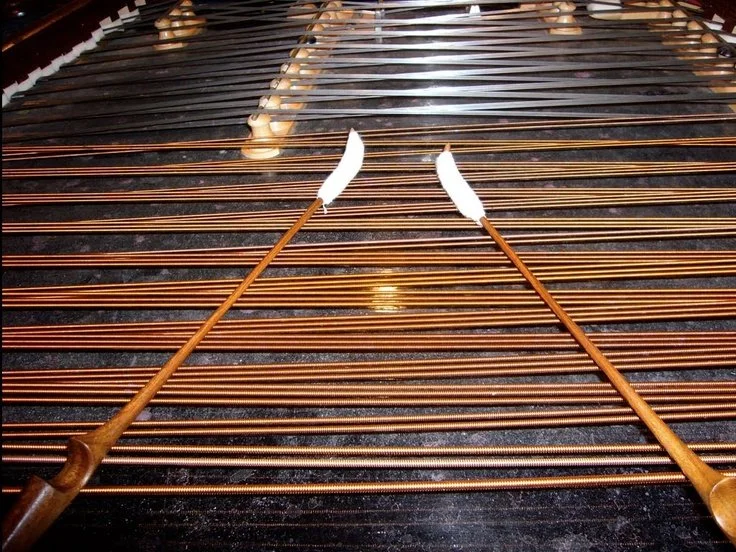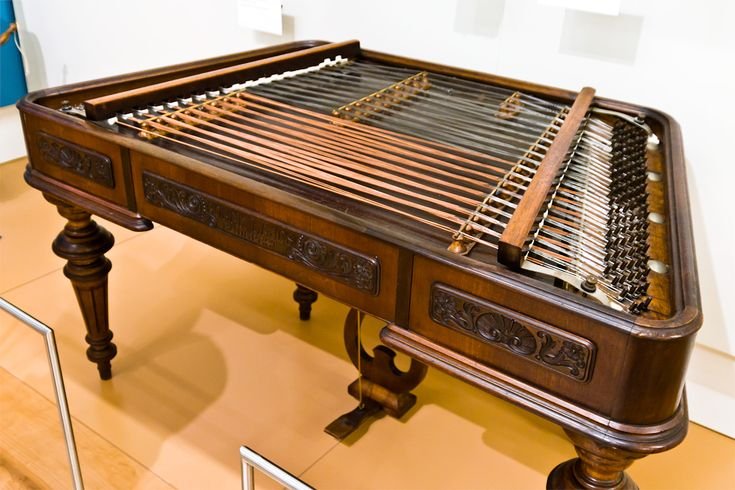Introduction
Integral to folk music of the countries Hugar, Slovakia, Ukraine, and Romania, the cimbalom has a unique sound and rich cultural history. Below is a breakdown of the structure, sound, history of origin, and versatility of this beautiful instrument.
Structure
The cimbalom is a traditional Slovakian instrument consisting of a trapezoidal box with approximately 125 metal strings stretched across its top. It is played by striking felt mallets. The instrument stands on four legs and is approximately a meter tall. It is supplied with a pedal, bringing the instrument to a weight of about 90kg. The strings attached are like piano wires but custom-made for the measurements of this specific instrument. With these strings, tones are a cross between the harp and piano, with a range of 4.5 to 5 octaves!
Sound
The sound of the cimbalom is quite captivating with its bell-like tones, resonance, and dynamic range. When listening to a piece of music on this instrument, it may sound metallic or shimmery like bells and chimes. When struck with a mallet, the strings of the instrument make vibrations within the wooden box, which is why the instrument may sound vibrant in rhythmic sections of music. These responsive strings also allow players to achieve a wide range of dynamics on the instrument, from delicate passages to powerful crescendos.
The cimbalom has a single pedal known as the dampening pedal attached to the bottom of the instrument. This pedal is much like the dampening pedal on the piano which means it does not affect high notes, in other words, cutting off specific notes. The intended effect of pressing your foot to this pedal is so the player can achieve a cleaner, more articulated sound, especially when playing staccato passages or when a shorter decay of measures is desired.
Many cimbalom pieces are filled with rolls and glissandos. Rolls are rapid, repetitive strikes on the same or adjacent strings that create a rolling effect and add texture to the pieces of music. Glissandos are done by players sliding their mallets along the strings, creating a smooth, sliding effect between pitches.
Technique
This instrument requires practice and technique to produce various sounds, from delicate melodies to powerful rhythms. Like other percussion instruments, the cimbalom technique consists of dynamic control, phrasing, and articulation. Players usually position themselves behind the instrument so they have access to all of the strings in the box. Next, players use mallets, typically felt or leather-covered, and strike the cords with varying degrees of force and angle to achieve different qualities. If the player is to make use of the dampening pedal to control the sustain and resonance of the instrument, they make slight movements with their ankles to reach the foot located near the ground. When fine-tuning the cimbalom for concerts, records, or folk performances, players often use a tuning hammer and then set out on the trying task of tuning the cords.
History
The origins of the cimbalom can be traced back to Persian and Byzantine instruments in the Middle East, which evolved over centuries into different varieties through central and eastern Europe. The cimbalom as we know it today can be traced back to Austrian-Hungarian history. In the 19th century it gained popularity with musicians as they began to incorporate it into
their pieces and later in 1890 became the nationalized instrument. In the 19th and 20th centuries, classical composers like Béla Bartók and Zoltán Kodály began to incorporate the cimbalom which is how the instrument elevated in status globally. Due to the ever-evolving use of the cimbalom it is no longer just found in folk pieces of music but classical compositions as well. Today the cimbalom is just beginning to weave its way into other forms of musical genres including jazz, contemporary music, and scores in theatre and film.
Versatility
In conclusion, the folk cimbalom is appreciated worldwide for its unique sound and versatility. The versatility of the cimbalom to cross genres lies in its ability to blend seamlessly into these different genres while still maintaining its distinct identity and cultural heritage. A great example of this is in the award-winning 2014 film, The Grand Budapest Hotel where the film score mainly consists of sounds of the cimbalom.
Written by Jacqueline Nicole Denson
7 Spotify Playlists that feature the Cimbalom:
https://open.spotify.com/album/6IV7472Hni7A1ENilCManS?si=Mz7-V-6xQFS_Wif4l57EPg https://open.spotify.com/playlist/0XTK7eBNmxIP5aVMmqOiiC?si=86f245a77307466a https://open.spotify.com/playlist/37i9dQZF1E4tz1u9JYPeBm?si=4ab2e30a62e84908 https://open.spotify.com/playlist/37i9dQZF1EIWuWQnPLSvOx?si=c268336b44424fa6 https://open.spotify.com/playlist/37i9dQZF1E4yrJF4pfJzWW?si=e4484b3890fd4a1e https://open.spotify.com/playlist/6GnaL7WcoM62Xe1BDiSCjT?si=b427b5d261834cc3 https://open.spotify.com/playlist/37i9dQZF1E4knAPP89YWJ5?si=3df421dd0c424ede
Sources
2015. Tolleism | Thoughts on new music performance, percussion, and cimbalom. https://tolleism.wordpress.com/.
“Richard Moore - History of the Cimbalom.” n.d. Richard Moore - Cimbalom Player. Accessed June 26, 2024. http://www.cimbalom.ca/cimbalom_history.aspx.





